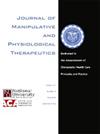妊娠和产后背部疼痛的部位与日常活动和工作参与限制之间的关系。
IF 1.4
4区 医学
Q4 HEALTH CARE SCIENCES & SERVICES
Journal of Manipulative and Physiological Therapeutics
Pub Date : 2023-03-01
DOI:10.1016/j.jmpt.2024.02.001
引用次数: 0
摘要
研究目的本研究的目的是:(1) 研究与妊娠有关的背痛的部位是否会影响日常生活活动和缺勤;(2) 确定哪种类型的疼痛更有可能在产后持续存在:这是对一项观察性队列研究数据的二次分析。数据于 2013 年至 2014 年在安大略省收集。研究确定了四个疼痛部位组别,包括腰背痛(LBP)、骨盆腰痛(PGP)、合并疼痛和混合疼痛。采用逻辑回归模型研究了疼痛部位对活动和缺勤的影响。描述性分析探讨了孕期疼痛部位与产后疼痛模式之间的关联:我们对 305 名孕妇进行了调查,并对其中 80 人进行了产后 6 个月的随访。数据分析显示,与仅有枸杞痛的受访者相比,合并有枸杞痛的受访者对就业(家庭以外)和自我梳洗的干扰增加了约 2 倍。与仅有枸杞痛的受访者相比,合并有枸杞痛和腰痛的受访者缺勤的可能性增加了约 5 倍;合并有腰痛和枸杞痛的受访者缺勤的可能性增加了 13 倍。约 50% 的受访者表示在产后 6 个月内没有疼痛感,16% 的受访者有持续疼痛感,38% 的受访者有持续疼痛感。孕期合并疼痛的受访者在产后 6 个月内仍有持续性疼痛:结果表明,妊娠相关背痛的部位与日常活动受干扰、缺勤增加和产后持续疼痛有关。在这组人群中,背痛并不总是在分娩后缓解,那些经历过与妊娠相关的合并疼痛的人在产后仍会出现症状。本文章由计算机程序翻译,如有差异,请以英文原文为准。
Relationship Between Location of Pregnancy-Related and Postpartum-Related Back Pain and Limitations of Daily Activities and Work Participation
Objective
The aims of this study were to (1) examine if the location of pregnancy-related back pain impacts activities of daily living and absence from work and (2) determine which types of pain were more likely to persist postpartum.
Methods
This was a secondary analysis of data from an observational cohort study. Data were collected in Ontario between 2013 and 2014. Four pain location groups were identified, including low back pain (LBP), pelvic girdle pain (PGP), combined pain, and mixed pain. Logistic regression models were used to examine the impact of pain location on activity and absence from work. Descriptive analyses explored the association between pregnancy pain location and postpartum pain patterns.
Results
We surveyed 305 pregnant participants and followed up with 80 of these participants up to 6 months postpartum. Data analysis showed approximately a 2-fold increase in interference with employment (outside the home) and self-grooming for those with combined pain compared to those only experiencing LBP. Respondents with PGP and combined PGP and LBP had approximately a 5-fold increased likelihood of absence from work compared to respondents with only LBP; those with a mixture of LBP and PGP had a 13-fold increase in likelihood. Approximately 50% of respondents reported being pain-free, 16% experienced lingering pain, and 38% experienced persistent pain within 6 months postpartum. Those with combined pain during pregnancy continued to have persistent pain up to 6 months postpartum.
Conclusion
The results suggest that the location of pregnancy-related back pain is associated with interference in daily activities, an increase in absence from work, and the persistence of postpartum pain. For this cohort, back pain did not always resolve after delivery, and those experiencing pregnancy-related combined pain continued to experience symptoms postpartum.
求助全文
通过发布文献求助,成功后即可免费获取论文全文。
去求助
来源期刊
CiteScore
3.00
自引率
7.70%
发文量
63
审稿时长
29 weeks
期刊介绍:
The Journal of Manipulative and Physiological Therapeutics (JMPT) is an international and interdisciplinary journal dedicated to the advancement of conservative health care principles and practices. The JMPT is the premier biomedical publication in the chiropractic profession and publishes peer reviewed, research articles and the Journal''s editorial board includes leading researchers from around the world.
The Journal publishes original primary research and review articles of the highest quality in relevant topic areas. The JMPT addresses practitioners and researchers needs by adding to their clinical and basic science knowledge and by informing them about relevant issues that influence health care practices.

 求助内容:
求助内容: 应助结果提醒方式:
应助结果提醒方式:


